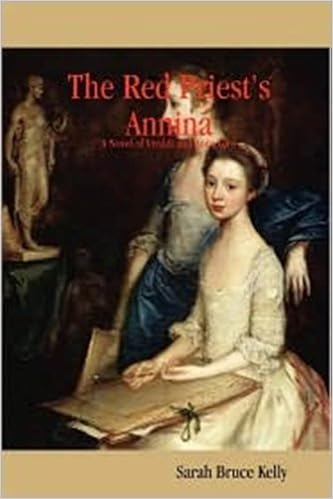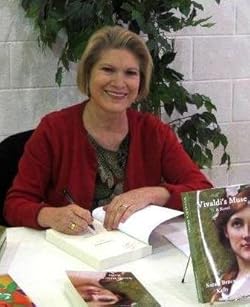___________________
MJN: Having grown up in the family of classical musicians, I
have deep appreciation for historical novels featuring the lives of composers
and musicians - and often the lesser known figures who were unfairly obscured. How
do you balance the ration of iconic and obscure characters?
SBK: Historical novels about composers and
musicians are rare. I realized this when I conceived the idea for my first
novel, The Red Priest’s Annina, and consequently I had no real “model”
to help guide me. I think the reason for this dearth of music-related
historical fiction is the necessity for an author to not only be intimately
familiar with musical terminology and techniques, but ideally to have
experience themselves in the performing arts. Fortunately my long background in
musical performance and education, along with my MA in music history and
research, gave me the necessary tools to portray historical musicians
convincingly within the context of the time and culture in which they lived.
Balancing
well-known characters, Vivaldi for instance, with more obscure characters, such
his protégée, Annina Girò, is an intriguing challenge but a challenge
nonetheless. Painstaking and meticulous research is the key, with a bit of
informed imagination thrown in. Historical letters, diaries, memoirs, reviews,
and other documents are helpful, but even more so are the “hunches” that come
about unexpectedly from less concrete sources. For example, I spent years
studying the music Vivaldi wrote for Girò, and the more I got to know her music
the better I got to know her as a person. Not only that, but the touching
nuances of the music he was inspired to create for her say a great deal about
the nature of their artistic and personal relationship. When such hunches are
backed up by documentary evidence something indeed “clicks,” and the story and
characters become all the more real.
MJN: The Red Priest's Annina is said to be written for
preteen and teen girls. I am happy to see so many historical novels targeted at
the young female readership. I have a friend who's an English teacher, and she
said that it's very hard to convince teenage girls to read historical fiction.
The common complaint they hear is, "What does this have to do with real
life?"
SBK: Many historical novels for young readers
focus on some sort of physical action or adventure set in a particular time and
place and often fall short of creating characters that young people can relate
to on an emotional level. These “costume dramas,”as they are sometimes called,
stem from models put forth by the entertainment industry, and their lack of
psychological depth usually fails to sustain the interest of young readers.
When I
first conceived the idea for The Red Priest’s Annina I had envisioned
Annina’s story as engaging young girls in particular. When the finished product
started to attract attention I was pleasantly surprised to learn that not only
girls, but boys as well as men and women of all ages were equally taken with
the story. I believe this was due to the deeply emotional nature of Annina’s
music which, as I mentioned above, made her so real for me that I was able to
portray her feelings, fears and desires in ways that made her real for readers.
This is what all readers, including young people, love to experience in
stories. If they can identify with a character on an emotional level they can
relate that character’s story to their own lives.
MJN: This is the second book that features a contralto. Last
year I read a novel "Goddess" about a French contralto Julie
d'Aubigny. My father was an operatic coach, and he told me that contraltos were
not in demand, and it was hard for a vocalist with that range to reach the same
diva status seemingly reserved for sopranos. There simply aren't enough leading
roles written for contraltos.
SBK: It’s true that there are few starring roles
in opera for contraltos. However Annina Girò was a mezzo soprano, a voice type
that was quite popular in the 18thcentury. This is why current-day
mezzos such as Cecelia Bartoli and Anne Sofie von Otter focus largely on the
Baroque era for their performance repertoire.
Keep
in mind also that the real super stars of 18th-century opera were
the castrati, castrated males. The term “diva” (goddess) didn’t come about
until the late 19thcentury, in connection with the “grand operas” of
Verdi and others whose works now dominate the stages of most opera houses. Vivaldi
himself favored the warmer, richer tones of the mezzo voice and wrote many
dazzling prima donna roles for Girò in that vocal range. Orlando Furioso,La
Griselda, and Rosmira Fidele are just a few examples.
MJN: In the past
decades, the Catholic Church has been subject of scrutiny. Liberal media loves
to demonize Catholic priests as predatory and hypocritical. So when you see a religious
figure portrayed in a benevolent, liberating light, it's refreshing.
SBK: An
intensive study of Vivaldi’s life and work is indeed gratifying and refreshing,
not to mention fascinating. He was a Catholic priest who devoted his life to
creating some of the most sparkling and innovative music of the 18th century.
His many hundreds of concertos, operas, and sacred works were composed in
praise of God and Mary, expressed by the unique monogram he inscribed at the
top of his musical scores, which means: “Praise be to God, and to Mary, the
Blessed Mother of God, Amen.
He was
blessed with extraordinary talents, which he used to put his faith into action.
Not only was he a brilliant composer and musician, he was also a gifted teacher
who shared the gift of music with countless students. Due to a respiratory
ailment he had since birth, he was unable to say Mass. Instead he devoted much
of his life to bringing the joy and magic of music into the lives of the
abandoned and the unwanted. He spent the better part of his career teaching
music at a foundling home, the Pietà, which was a refuge for homeless girls.
The all-girl orchestra and chorus he established there became internationally
renowned, and visitors from all over Europe came to Venice to hear them perform.
As for
his long association with Annina Girò, my many years of research did not turn
up anything to indicate they were ever anything more than good friends and
artistic collaborators. Vivaldi himself referred to their relationship as an amicizia,
which means a “close friendship.”
MJN: You make a rapid switch from Vivaldi's Venice to 1920s
Pittsburg. Social norms have certainly changed in terms of religious freedom
and gender roles, and yet many of the challenges that musicians face have
remained the same. Artists are still vulnerable to the whims of their benefactors
and unwanted attention from fans who don't respect boundaries.
SBK: As I see it, there are more similarities than
differences between the stories told in The Red Priest’s Annina and Jazz
Girl, and I was inspired to write both for much the same reasons. True,
Mary’s world—an inter-racial Pittsburgh neighborhood in the 1920s—was quite
different from the environment Annina experienced in 1720s Venice. But the
contrasts between these settings simply provide different frames for the two
heroines’ stories.
The
similarities between the stories are much more significant. Both Annina and
Mary were self-driven to master their musical gifts from an early age. Each had
serious obstacles in their way, including disinterested mothers and
dysfunctional home situations. Both girls were fortunate to attract the
attention of adult mentors who helped guide them toward achieving their goals.
Indeed,
the long, hard road to musical stardom has not changed much over the centuries.
Young women in particular have always had their own particular challenges to
face, and both Annina’s and Mary’s stories exemplify this truth. It was and
continues to be an honor and a privilege for me to share the stories of these
two unsung heroines in the history of music!



No comments:
Post a Comment